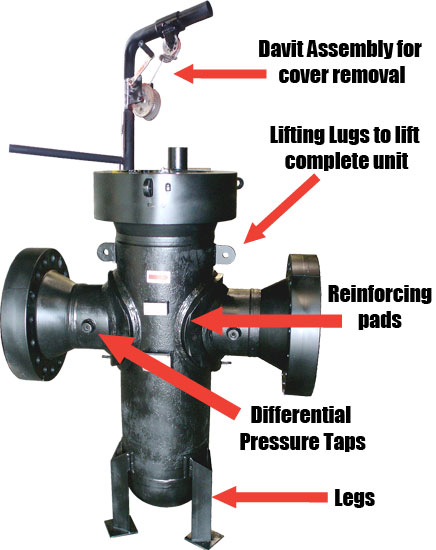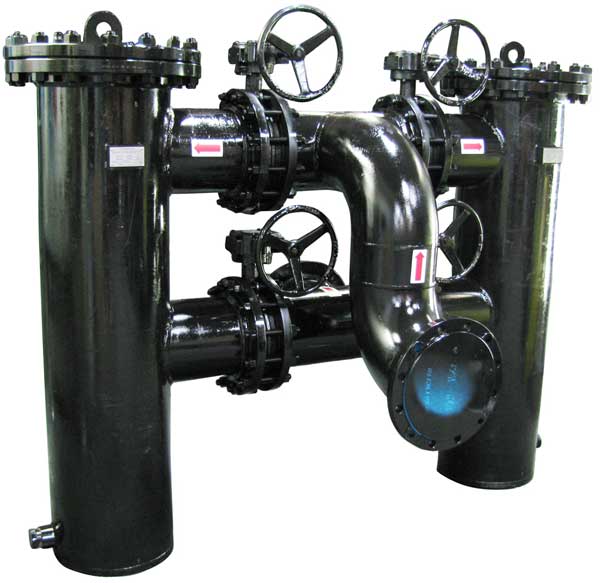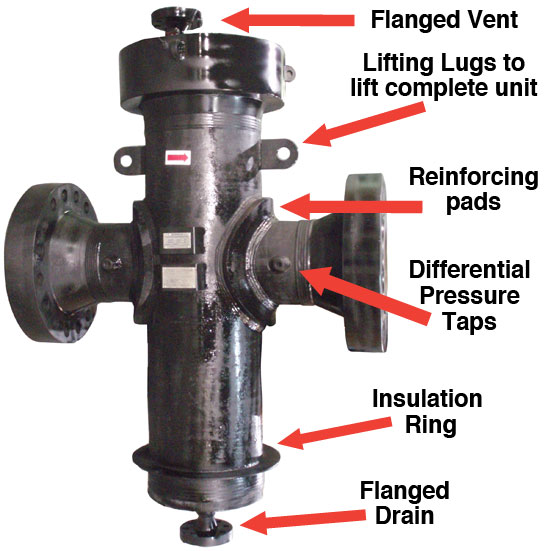We try and keep our blogs as informative as possible. Even though we seem to be overwhelmed with information these days, when it comes to the technical elements of the high quality industrial valves and strainers produced by Sure Flow Equipment, readers seem to appreciate opportunities to learn more about how our products can offer solutions to engineering challenges.
We recently discussed our quick opening closures that do not require tools for opening and closing. We provided a detailed photograph where we had indicated some of the features of several of our units.
This inspired us to expand on some of the features outlined in the photograph.
Most components that make up these units are extremely heavy. The quick opening closure on the top of many of our units is so heavy on its own that it requires a Davit Assembly to allow an operator to open it for maintenance. When you attach this to one of our high-quality steel strainer units, some of the units have to be measured in tons.
So when the unit is being fabricated we install lifting lugs which allow the entire unit to be lifted safely with a crane during shipping and installation. While straps might do the job, the lifting lugs improve safety and maneuverability on installation.

Lifting lugs are often located on the cover of the unit like in the photo below.

Part way down the labeled photos we have indicated the “Differential Pressure Taps.” These are also often referred to as “Delta P Taps.” We recently discussed differential pressure gauges which are an excellent assistance to monitor pressure drop across the basket.
These taps are built into the design to allow a differential pressure gauge to be added in the future. With a high-pressure unit like this it would be extremely difficult to add these to the unit after it was completed, so Sure Flow incorporated them into the original design in case they are required in the future.
Sure Flow has some customers that prefer to install their own differential pressure gauge on-site. They can either do it when they install the unit or in the future if required.
In some complex industrial applications we’ve found that customers will have sourced this equipment from a specialized supplier, so they will have their own gauge/switch/transmitter, potentially consistent across a variety of areas in their plant. As plants have become more automated these often involve remote communication back to a central control unit. This type of system can be wireless and sometimes it makes sense to source all these types of sensors and monitoring equipment from the supplier that aggregates them into the central monitoring station.
If Sure Flow does not provide the gauge, the differential pressure taps are plugged with threaded plugs. We then hydrotest the unit with these plugs in, so that we have complete confidence in the quality of the unit.
One of the other notable features of these units were the “reinforcing pads” or “repads.” These are sometimes used in high pressure and/or large size designs.
When a custom strainer is fabricated, the body of the strainer has two holes cut in it for the nozzles (inlet and outlet). It is cut from pipe sized for the application.
The holes cut into the pipe weaken the shell pipe, reducing the pressure rating.
The ASME B&PV Code has rules/calculations to determine the pressure rating of the strainer. There are a number of variables and calculations, but one thing it looks at is the holes being cut out of the shell pipe.
For units being fabricated for higher pressure conditions sometimes you have to add extra material to make up for the material you removed when you cut the holes. These are called reinforcing pads or repads.
The reinforcing pads are typically plate that are bent or formed to the outside diameter of the shell/body. The inlet and outlet are welded to the shell, then the reinforcing pads are added and welded to the shell and the nozzles.
You can tell from the photo these are extremely heavy-duty units, and nothing out of the ordinary for our fabrication team.

Sure Flow Equipment strainers are often installed into an industrial process where other components are insulated so customers sometimes add insulation after the unit is installed. A basket strainer like this that would be installed in an upright or vertical position and insulation would have a tendency to shift down the unit with time, vibration and other operating conditions.
In the photo above you see an insulation ring which prevents the insulation from sliding down the unit while operating.
Insulating an inline strainer can increase the efficiency of the industrial process by reducing temperature drop from having the strainer uninsulated.
Sometimes strainers/pipelines are insulated to protect operators or staff that may work near the system from elevated temperatures of otherwise bare metals.
Providing a convenient way for our customers to save money and improve efficiency is built into our core business strategy. These aren’t ‘bells and whistles’ we’re providing to help make a sale. They are strategic and proven tools and features that can help our customers operate more safely and efficiently.
If you have any further questions about these or any of the other options available on Sure Flow industrial strainers and valves, please call us today and talk to our exceptional product specialists.

